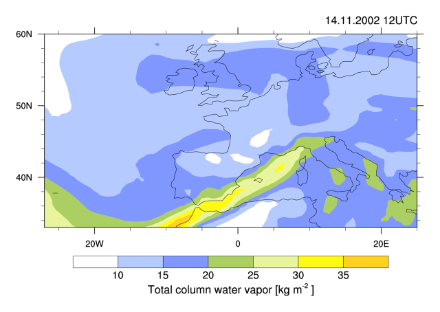Service Navigation
Search
An atmospheric river is a long and narrow corridor of air in which intense moisture transport takes place. Atmospheric rivers are typically longer than 2000 km and occur between 0 and 2km altitude. They play an important role in the transport of moisture from the tropical regions towards the mid-latitudes.
Atmospheric rivers are often connected to extratropical cyclones and occur in their warm sector, just ahead of the cold front. Between 13 and 17 November, a perturbation passed over Switzerland and was accompanied by an atmospheric river. This atmospheric river is visible in the figure below where high moisture values are found, i.e. approximately where the total column water vapor is larger than 20 kg/m2, namely over the Atlantic Ocean, the north-western part of Africa and the Mediterranean Sea.

The atmospheric river transported very moist and warm air towards Switzerland in a south-westerly to southerly flow between 14 and 16 November. The transport and ascent of this air over the Alpine relief created heavy orographic precipitation over the Alps and over the southern side of the Alps. The persistence of the transport of large quantities of moisture between 14 and 16 November caused heavy precipitation to occur over these regions during three consecutive days.
On 17 November, the perturbed zone moved eastwards, the atmospheric river faded away and the precipitation decreased considerably over the Alpine region.